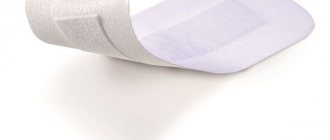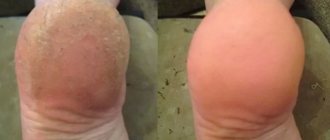Nicorette translucent patch Plaster, sachet, 7 pcs, 10/16 mg/h
Directions for use and doses
Adults and elderly people: The patch is applied to an intact area of skin immediately after waking up in the morning and removed before going to bed. Treatment with this drug simulates the fluctuations in nicotine concentrations throughout the day in a smoker; Moreover, during sleep, nicotine does not enter the body. The use of a transdermal patch during the day does not cause the disturbances observed when nicotine enters the body during sleep. Heavy smokers (more than 20 cigarettes per day) are recommended to start with stage 1 of therapy, using 1 patch of 25 mg/16 hours daily for 8 weeks. Then begin a gradual reduction in the dose of the drug: 1 patch of 15 mg/16 hours, daily, for 2 weeks, and then - 1 patch of 10 mg/16 hours, daily, for 2 weeks. Light smokers (10-20 cigarettes per day) are recommended to start therapy with stage 2 (15 mg) for 8 weeks, then reduce the dose to stage 3 (10 mg) for the final 4 weeks. In most cases, the use of a transdermal patch for more than 6 months is not recommended. However, some people may need longer therapy to avoid relapse into smoking. How to Apply the Transdermal Patch (Patient Information): The Nicorette patch should be applied to dry, clean, intact, hair-free skin such as the thighs, upper limbs, or chest. It is necessary to change the application site every day: do not use the same area for two consecutive days. 1. Before applying the patch, wash your hands thoroughly.2. Cut the plaster package with scissors along the edge as indicated on it. Select a clean, dry, hair-free area of skin (such as the thigh, upper limb, or chest).3. Remove one half of the silver aluminized protective film without touching the adhesive surface of the patch.4. Strengthen the part of the patch freed from the protective film on the skin and remove the remaining half of the silver aluminized protective film.5. Press the patch firmly against the skin with your palm or fingertips.6. Run your finger along the edge of the patch, making sure it is firmly attached. In combination with chewing gum: The Nicorette patch can also be used in conjunction with Nicorette chewing gum at a dosage of 2 mg in situations where, while using the patch, a person continues to periodically experience an irresistible urge to smoke, or if it was not possible to quit smoking using only chewing gum or just a patch. In combination with the Nicorette patch, Nicorette chewing gum with a dosage of 2 mg allows you to quickly relieve strong urges to smoke when necessary. Initial therapy: Treatment should begin with a 25 mg/16 hour patch (stage 1) in combination with 2 mg chewing gum. In this case, use at least 4 chewing gums (2 mg dosage) per day; usually 5-6 chewing gums are enough. The number of chewing gums should not exceed 15 pieces/day. Usually the general course of treatment lasts for 8 weeks. After this, the dose of nicotine should be reduced gradually. The patch is applied immediately after waking up in the morning and removed before going to bed. The Nicorette patch should be applied to dry, clean, intact, hair-free skin, such as the thighs, upper limbs, or chest. It is necessary to change the application site every day: do not use the same area for two consecutive days. After applying the patch, you should wash your hands thoroughly to avoid eye irritation from possible nicotine contact. Withdrawal of combination therapy: There are two ways to discontinue combination therapy. Method 1: Over the next 2 weeks, switch from the 25 mg/16 hour patch (Stage 1) to the 15 mg/16 hour patch (Stage 2), and then over the next 2 weeks to the 10 mg/16 hour patch (Stage 3). ), while maintaining the amount of chewing gum used at a dosage of 2 mg, as in initial therapy. Next, the amount of chewing gum is gradually reduced until complete abolition for the time that a person needs depending on his needs, but no later than 12 months after the start of combination therapy. Method 2: consists of completely canceling the patch immediately after the end of the initial therapy phase. Next, the amount of chewing gum is gradually reduced at a dosage of 2 mg until complete discontinuation for the time that a person needs depending on his needs, but no later than 12 months after the start of combination therapy.
Nicorette spray for local use 1 mg/dose 150 doses (Johnson)
For application to the oral mucosa. The patient should do everything possible to permanently quit smoking while being treated with Nicorette® spray. Adults over 18 years of age Nicorette® Spray should be used at the moment when an irresistible urge to smoke occurs. After preparing the spray for use (see below for Instructions for Use when using the spray for the first time), place the tip of the spray as close to your open mouth as possible. Press the dispenser from above, thus releasing one dose of the drug into the oral cavity; Avoid getting the spray on your lips. To prevent the substance from entering the respiratory tract, do not inhale when pressing the dispenser. For best results, do not swallow saliva for several seconds after injection. While using the spray, eating and drinking is not recommended. If symptoms of overdose appear (see section “Overdose”), use of the drug must be stopped immediately. Complete smoking cessation Nicorette® Spray should be used in all cases of craving for smoking or to prevent cravings in situations that may provoke it. Smokers who want or are able to quit smoking immediately should immediately replace smoking cigarettes with Nicorette® spray and, as soon as possible, reduce the number of injections until they stop completely. If you completely quit smoking, take 1 or 2 injections during the period of time when you usually smoked a cigarette, as well as if you have a craving for smoking. If after a single injection the craving for smoking does not decrease within a few minutes, a second injection should be made. If two doses are required, subsequent application of the spray may consist of 2 consecutive injections. Every hour you are allowed to take no more than 4 dosed injections of the spray. Do not inject more than 2 doses of spray at a time or use more than 64 doses per day (or 4 doses per hour for 16 hours). Each bottle contains at least 150 doses. The average course of use of the spray at the indicated dose is 6 weeks. Then you should begin to reduce the number of injections so that by the end of the 9th week the number of doses is half the average number of doses per day received in the first 6 weeks, and during the 12th week - no more than 4 doses per day. When the daily dose drops to 2-4 injections, use of the spray should be discontinued. After completion of therapy, to prevent a return to smoking, patients can use Nicorette® spray if they have an irresistible urge to smoke. In such situations, you can make 1 injection, and if after a single injection the craving for smoking does not decrease within a few minutes, you should make a second injection. In this case, you should not exceed 4 dosed injections per day. Regular use of the spray for more than 6 months is usually not recommended, but some patients may require longer therapy to avoid relapse into smoking. Reducing the number of cigarettes smoked Smokers who want to reduce the number of cigarettes they smoke should use the spray as needed between smoking episodes to increase the amount of time between smoking and to reduce smoking as much as possible. Once readiness is felt, smokers should aim to quit completely. After quitting smoking, you should follow the recommendations for therapy and gradual dose reduction indicated above for complete smoking cessation. Behavioral therapy and psychological support usually increase treatment success. Those who have managed to quit smoking but find it difficult to give up the spray are advised to consult a doctor for medical help. Temporary smoking cessation The spray can be used during periods when it is necessary to abstain from smoking, for example, when in places where smoking is prohibited, or in other situations when it is necessary to abstain from smoking. The maximum daily dose for temporary smoking cessation is 64 doses. In combination with a transdermal patch For smokers with a severe nicotine addiction (more than 20 cigarettes per day) or experiencing an irresistible craving for smoking, or smokers who have not been able to quit smoking using only one type of nicotine replacement therapy, it is possible to use a spray for the mucous membrane Nicorette® oral membranes in combination with Nicorette® transdermal patch for rapid relief of smoking cravings. The patch is applied to an intact area of skin immediately after waking up in the morning and removed before going to bed. The patch should be applied to dry, clean, intact, hair-free skin, such as the thighs, upper limbs or chest. It is necessary to change the application site every day: do not use the same area for two consecutive days. After applying the patch, wash your hands thoroughly to avoid eye irritation from possible nicotine contact. Initial therapy: Treatment should begin with a 25 mg/16 hour patch (stage 1) in combination with a 1 mg/dose spray. Usually 13 doses of spray per day are sufficient. The maximum daily dose of the spray is 32 doses. Patients should completely stop smoking during therapy. Usually the general course of treatment lasts for 8 weeks. After this, the dose of nicotine should be gradually reduced. Withdrawal of combination therapy: There are two ways to discontinue combination therapy. Method 1: Over the next 2 weeks, switch from the 25 mg/16 hour patch (Stage 1) to the 15 mg/16 hour patch (Stage 2), and then, over the next 2 weeks, to the 10 mg/16 hour patch ( stage 3), while maintaining, if necessary, the number of doses of Nicorette® spray used, as with Initial therapy. Next, the number of doses of the spray is gradually reduced until complete withdrawal for the time that the patient needs depending on his needs, but no later than 12 months after the start of combination therapy. Method 2: involves completely removing the patch immediately after completing the Initial Therapy phase. Next, gradually reduce the number of doses of Nicorette® spray until complete withdrawal during the time that the patient needs depending on his needs, but no later than 12 months after the start of combination therapy. Children and adolescents under 18 years of age The drug is not recommended for use by persons under 18 years of age. There is no experience in treating adolescents under 18 years of age with the spray.
How does the Nicorette patch work?
Those who have tried to quit smoking on their own are very familiar with the unpleasant withdrawal symptoms.
The Nicorette patch contains therapeutic concentrations of nicotine that help you get through withdrawal periods much easier and faster. If it is not used, the person will be tormented by the following phenomena:
- irritability, anxiety;
- memory impairment;
- low labor productivity, decreased concentration and thinking abilities;
- Bad mood;
- change in heart rate;
- "jumps" in pressure;
- insomnia.
Using the patch gently alleviates these symptoms. The nicotine from the patch is absorbed by the skin and enters the bloodstream. Its quantity is not enough to poison the body, but it is quite enough to eliminate the signs of smoking withdrawal.
Nicorette®
Adults and elderly people
The patch is applied to an intact area of skin immediately after waking up in the morning and removed before going to bed. Treatment with this drug simulates the fluctuations in nicotine concentrations throughout the day in a smoker; Moreover, during sleep, nicotine does not enter the body. The use of a transdermal patch during the day does not cause the disturbances observed when nicotine enters the body during sleep.
Heavy smokers (more than 20 cigarettes per day)
It is recommended to start with stage 1 of therapy, using 1 patch of 25 mg/16 hours, daily, for 8 weeks. Then begin a gradual reduction in the dose of the drug: 1 patch of 15 mg/16 hours, daily, for 2 weeks, and then - 1 patch of 10 mg/16 hours, daily, for 2 weeks.
Non-heavy smokers (10-20 cigarettes per day)
It is recommended to start therapy with stage 2 (15 mg) for 8 weeks, then reduce the dose to stage 3 (10 mg) for the final 4 weeks.
| Heavy smokers | Light smokers | ||||
| Dosage regimen | Duration | Dosage regimen | Duration | ||
| Stage 1 | Nicorette® patch 25 mg | First 8 weeks | — | — | — |
| Stage 2 | Nicorette® patch 15 mg | Next 2 weeks | Stage 2 | Nicorette® patch 15 mg | First 8 weeks |
| Stage 3 | Nicorette® patch 10 mg | Last 2 weeks | Stage 3 | Nicorette® patch 10 mg | Last 4 weeks |
In most cases, use of the transdermal patch for more than 6 months is not recommended. However, some people may need longer therapy to avoid relapse into smoking.
How to apply a transdermal patch (patient information)
The Nicorette® patch should be applied to dry, clean, intact, hair-free skin, such as the thighs, upper limbs or chest. It is necessary to change the application site every day: do not use the same area for two consecutive days.
1. Wash your hands thoroughly before applying the patch.
2. Use scissors to cut the patch package along the edge as indicated on the package. Select a clean, dry, hair-free area of skin (such as the thigh, upper limb, or chest).
3. Remove one half of the silver aluminized protective film without touching the adhesive surface of the patch.
4. Fasten the part of the patch freed from the protective film to the skin and remove the remaining half of the silver aluminized protective film.
5. Press the patch firmly against the skin with your palm or fingertips.
6. Run your finger along the edge of the patch, making sure it is firmly attached.
Please note that only a new patch should be applied the next day.
Which is better - Nicorette patch or spray?
The use of the Nicorette smoking cessation patch is convenient because nicotine enters the bloodstream slowly but constantly. This product is perfect for those people who are used to smoking a lot and quite often during the day.
Thanks to its form, Nicorette spray almost instantly suppresses the acute, sometimes unbearable desire to smoke. That is why it will be a very good helper for those people who suffer from the desire to smoke after stress, for example, during troubles at work, but in ordinary life they smoke moderately or lightly. The spray quickly stops the craving for smoking, and the patch develops the habit of doing without cigarettes.
Using the Nicorette patch for ulcerative colitis
There is evidence that the nicotine contained in Nicorette patches can help in the treatment of a complex and extremely unpleasant disease - ulcerative colitis, or chronic intestinal inflammation.
This occurs due to the anti-inflammatory properties of nicotine, which improves intestinal motility and stimulates the formation of a fairly dense and effective protective layer of mucus. It has also been confirmed that nicotine is a provitamin, which in the human body can be converted into vitamin B3, which is important for health and normal functioning, also called “vitamin PP”. Nicotinamide or nicotinic acid is the only vitamin in existence that is recognized by official modern medicine as a self-administered medicine. Conclusions that made it possible to link the positive effect of nicotine on the condition of patients with ulcerative colitis were made using a statistical method.
Doctors noticed that in smoking patients the number of cases of ulcerative colitis is much less than in people who have never used tobacco in any form. At the same time, when previously ill people quit smoking, relapses and exacerbations of the disease are observed, and the number of cases of colitis increases sharply.
Since the remaining components of tobacco are carcinogens or toxic products, it was concluded that nicotine is a limiting factor in the development of ulcerative colitis. The content of pure nicotine in the Nicorette patch is sufficient to reduce and even completely eliminate the signs of this extremely unpleasant disease.
Where to apply the Nicorette patch
Nicorette is almost transparent, its outer part is flesh-colored, it is small in size and almost invisible on the skin. Its use will not be made public unless you choose to talk about it.
You can attach the patch almost anywhere, but most often it is done on the upper arms. This makes it much easier to control, remove and stick on; usually these parts of the body are covered with sleeves.
But if desired, the patch can be used on any part of the body, you just need to avoid contact with mucous membranes and wash your hands thoroughly after using the product. Apply the product only to clean, dry, intact and non-inflamed skin, as hair-free as possible.
Side effects of using Nicorette
There are a number of contraindications to the use of the drug:
- High sensitivity to nicotine or patch components.
- History of myocardial infarction.
- The presence of some forms of angina.
- Arrhythmia in severe forms.
- Stroke.
- Chronic skin diseases.
- The presence of damage or inflammation of the skin at the site of application of the product.
In addition to obvious contraindications, the following side effects may be detected during use of the product:
- Some users (about 20% of all who used the patch) experienced minor skin irritations at first after starting to use the product, which went away after the body got used to it.
- Dizziness and headache.
- Urticaria or local inflammation of the skin, itching.
- Drowsiness, lethargy, apathy.
- Overexcitement, increased irritability, nervousness.
- Palpitations, arrhythmia, shortness of breath, feeling of tightness in the chest.
- Indigestion, discomfort, diarrhea or constipation, flatulence.
- Increased appetite and associated weight gain.
- Cough, dry mouth, changes in taste.
- The appearance of aphthous ulcers on the mucous membranes of the mouth.
- Muscle and joint pain, trembling limbs, back pain.
- Sleep problems, insomnia.
- Attention disorders.
- Vision disorders.
In most cases, these problems arise at the very beginning of using nicotine patches and most often they are associated precisely with the dosage of the product used. Sometimes quick elimination of side effects can be achieved by simply changing the patch to another one containing less nicotine. If unpleasant symptoms do not disappear, and even more so if they intensify, the use of the drug will have to be discontinued. The doctor will be able to choose another remedy that does not cause such side effects. It should be noted that most of the above adverse reactions are extremely rare and are not always clearly and noticeably expressed, therefore, in the vast majority of cases, the Nicorette patch is well tolerated and does not provoke any negative effects, or they do not cause much concern to the person.




